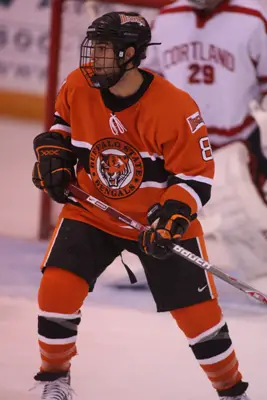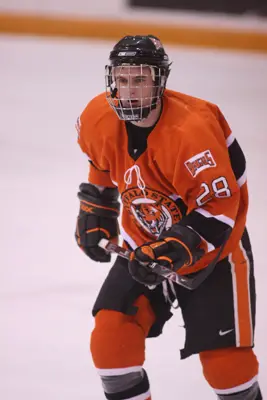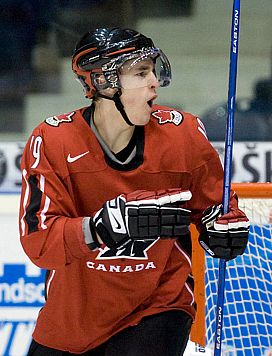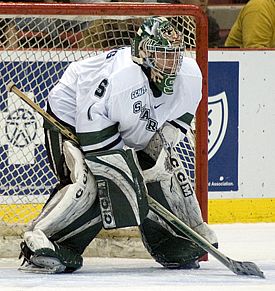It’s time once again to do what we like to call Bracketology — College Hockey Style. It’s our weekly look at how the NCAA tournament would look if the season ended today.
It’s a look into what are the possible thought processes behind selecting and seeding the NCAA tournament teams.
This is another installment of Bracketology, and we’ll be bringing you a new one every week until we make our final picks before the field is announced.
Here are the facts:
• Sixteen teams are selected to participate in the national tournament.
• There are four regional sites (East — Albany, N.Y.. Northeast — Worcester, Mass., Midwest — Madison, Wis., West — Colorado Springs, Colo.)
• A host institution which is invited to the tournament plays in the regional for which it is the host, and cannot be moved. There are four host institutions this year, Rensselaer in Albany, Holy Cross in Worcester, Wisconsin in Madison and Colorado College in Colorado Springs.
• Seedings will not be switched, as opposed to years past. To avoid undesirable first-round matchups, including intra-conference games (see below), teams will be moved among regionals, not reseeded.
Here are the NCAA’s guidelines on the matter, per a meeting of the Championship Committee:
In setting up the tournament, the committee begins with a list of priorities to ensure a successful tournament on all fronts including competitive equity, financial success and likelihood of playoff-type atmosphere at each regional site. For the model, the following is a basic set of priorities:
• The top four teams as ranked by the committee are the four No. 1 seeds and will be placed in the bracket so that if all four teams advance to the Men’s Frozen Four, the No. 1 seed will play the No. 4 seed and the No. 2 seed will play the No. 3 seed in the semifinals.
• Host institutions that qualify will be placed at home.
• No. 1 seeds are placed as close to home as possible in order of their ranking 1-4.
• Conference matchups in the first round are avoided, unless five or more teams from one conference are selected, then the integrity of the bracket will be preserved.
• Once the six automatic qualifiers and 10 at-large teams are selected, the next step is to develop four groups from the committee’s ranking of 1-16. The top four teams are the No. 1 seeds. The next four are targeted as No. 2 seeds. The next four are No. 3 seeds and the last four are No. 4 seeds. These groupings will be referred to as “bands.”
The biggest change this year is the fact that in past years the NCAA included a bonus factor for “good” nonconference wins. This year, it is no more. There are no more bonus points for anything.
So it becomes pretty easy this year, doesn’t it? Take the straight PairWise Rankings (PWR) and then follow the rules and you have the tournament. It’s that easy, right?
You know better than that.
Given these facts, here are the top 16 of the current PWR, and the current conference leaders (through all games of January 28, 2008):
1 Miami
2 Michigan
3 Denver
4 New Hampshire
5 Colorado College
6 North Dakota
7 Michigan State
8t Clarkson
8t Notre Dame
10 Boston College
11 Providence
12 Minn.-Duluth
13t Northeastern
13t Wisconsin
15 Mass.-Lowell
16 Massachusetts
— Bemidji State
— RIT
Current conference leaders:
Atlantic Hockey: RIT
CHA: Bemidji State
CCHA: Michigan
ECAC: Clarkson
Hockey East: New Hampshire
WCHA: Colorado College
Notes
• Bracketology assumes that the season has ended and there are no more games to be played; i.e., the NCAA tournament starts tomorrow.
• Because there are an uneven amount of games played inside each conference, I will be using winning percentage, not points accumulated, to determine who the current leader in each conference is. This team is my assumed Conference Tournament Champion.
Step One
From the committee’s report, choose the 16 teams in the tournament.
We break ties in the PWR by looking at the individual comparisons among the tied teams, and add in any current league leaders that are not currently in the Top 16. The only teams not listed are Bemidji State and RIT.
Let’s look at the ties, which consist of Notre Dame and Clarkson at eight and Northeastern and Wisconsin at 13.
Head-to-head we get Notre Dame and Northeastern besting their bubbles.
Therefore the 16 teams in the tournament, in rank order, are:
1 Miami
2 Michigan
3 Denver
4 New Hampshire
5 Colorado College
6 North Dakota
7 Michigan State
8 Notre Dame
9 Clarkson
10 Boston College
11 Providence
12 Minn.-Duluth
13 Northeastern
14 Wisconsin
15 Bemidji State
16 RIT
Step Two
Now it’s time to assign the seeds.
No. 1 Seeds – Miami, Michigan, Denver, New Hampshire
No. 2 Seeds – Colorado College, North Dakota, Michigan State, Notre Dame
No. 3 Seeds – Clarkson, Boston College, Providence, Minn.-Duluth
No. 4 Seeds – Northeastern, Wisconsin, Bemidji State, RIT
Step Three
Place the No. 1 seeds in regionals. Following the guidelines, there are no host teams in this grouping, so that rule does not need to be enforced.
We now place the other No. 1 seeds based on proximity to the regional sites.
No. 1 Miami is placed in the Midwest Regional in Madison.
No. 2 Michigan is placed in the East Regional in Albany.
No. 3 Denver is then placed in the West Regional in Colorado Springs.
No. 4 New Hampshire is placed in the Northeast Regional in Worcester.
Step Four
Now we place the other 12 teams so as to avoid intra-conference matchups if possible.
Begin by filling in each bracket by banding groups. Remember that teams are not assigned to the regional closest to their campus sites by ranking order within the banding (unless you are a host school, in which case you must be assigned to your home regional).
If this is the case, as it was last year, then the committee should seed so that the quarterfinals are seeded such that the four regional championships are played by No. 1 v. No. 8, No. 2 v. No. 7, No. 3 v. No. 6 and No. 4 v. No. 5.
So therefore:
No. 2 Seeds
Because Colorado College is hosting a regional, it is placed first.
No. 5 Colorado College is placed in No. 3 Denver’s Regional, the West Regional.
No. 8 Notre Dame is placed in No. 1 Miami’s Regional, the Midwest Regional.
No. 7 Michigan State is placed in No. 2 Michigan’s Regional, the East Regional.
No. 6 North Dakota is placed in No. 4 New Hampshire’s Regional, the Northeast Regional.
No. 3 Seeds
Our bracketing system has one Regional containing seeds 1, 8, 9, and 16, another with 2, 7, 10, 15, another with 3, 6, 11, 14 and another with 4, 5, 12 and 13.
Therefore:
No. 9 Clarkson is placed in No. 8 Notre Dame’s Regional, the Midwest Regional.
No. 10 Boston College is placed in No. 7 Michigan State’s Regional, the East Regional.
No. 11 Providence is placed in No. 5 Colorado College’s Regional, the West Regional.
No. 12 Minn.-Duluth is placed in No. 6 North Dakota’s Regional, the Northeast Regional.
No. 4 Seeds
One more time, taking No. 16 v. No. 1, No. 15 v. No. 2, etc.
Since Wisconsin is hosting a regional, it must be placed first.
No. 14 Wisconsin is sent to Miami’s Regional, the Midwest Regional.
No. 16 RIT is sent to Michigan’s Regional, the East Regional
No. 15 Bemidji State is sent to Denver’s Regional, the West Regional.
No. 13 Northeastern is sent to New Hampshire’s Regional, the Northeast Regional.
The brackets as we have set them up:
West Regional:
Bemidji State vs. Denver
Providence vs. Colorado College
Midwest Regional:
Wisconsin vs. Miami
Clarkson vs. Notre Dame
East Regional:
RIT vs. Michigan
Boston College vs. Michigan State
Northeast Regional:
Northeastern vs. New Hampshire
Minn.-Duluth vs. North Dakota
Our first concern is avoiding intra-conference matchups. We have the two in the Northeast Regional in Northeastern vs. New Hampshire and Minn.-Duluth vs. North Dakota. We cannot switch out Wisconsin, so we make the change of Northeastern and Bemidji State.
Then we can’t move Minn.-Duluth to the West Regional because it creates another intra-conference matchup, so we swap the Bulldogs with Boston College.
So the tournament is now fixed.
West Regional:
Northeastern vs. Denver
Providence vs. Colorado College
Midwest Regional:
Wisconsin vs. Miami
Clarkson vs. Notre Dame
East Regional:
RIT vs. Michigan
Minn.-Duluth vs. Michigan State
Northeast Regional:
Bemidji State vs. New Hampshire
Boston College vs. North Dakota
Let’s examine our brackets and see what we like and what we dislike.
The most glaring one is that overall number-one seed Miami is facing Wisconsin. In Madison.
And attendance in Albany will be horrific.
What, oh what, can we do?
Let’s start again, knowing that what we have already done doesn’t work out so well for our overall number-one seed.
Last week I hesitated to move Michigan out of the number-one overall seed because of attendance issues, as I thought it would mess with the integrity of the bracket. But moving the number-one overall seed away from the closest venue to have it avoid the number 14 seed — now that is good reasoning for protecting the integrity of the bracket.
So let’s reseed with one different move to start out with and see what we get. Let’s give the number-one overall seed, Miami, a placement in Albany, the East Regional.
Redo Starting From Step 3 Above
Place the No. 1 seeds in regionals. Following the guidelines, there are no host teams in this grouping, so that rule does not need to be reinforced.
We now place the other No. 1 seeds.
No. 1 Miami is placed in the East Regional in Albany.
No. 2 Michigan is placed in the Midwest Regional in Madison.
No. 3 Denver is then placed in the West Regional in Colorado Springs.
No. 4 New Hampshire is placed in the Northeast Regional in Worcester.
Step Four
Now we place the other 12 teams so as to avoid intra-conference matchups if possible.
Begin by filling in each bracket by banding groups. Remember that teams are not assigned to the regional closest to their campus sites by ranking order within the banding (unless you are a host school, in which case you must be assigned to your home regional).
If this is the case, as it was last year, then the committee should seed so that the quarterfinals are seeded such that the four regional championships are played by No. 1 v. No. 8, No. 2 v. No. 7, No. 3 v. No. 6 and No. 4 v. No. 5.
So therefore:
No. 2 Seeds
Because Colorado College is hosting a regional, it is placed first.
No. 5 Colorado College is placed in No. 3 Denver’s Regional, the West Regional.
No. 8 Notre Dame is placed in No. 1 Miami’s Regional, the East Regional.
No. 7 Michigan State is placed in No. 2 Michigan’s Regional, the Midwest Regional.
No. 6 North Dakota is placed in No. 4 New Hampshire’s Regional, the Northeast Regional.
No. 3 Seeds
Our bracketing system has one Regional containing seeds 1, 8, 9, and 16, another with 2, 7, 10, 15, another with 3, 6, 11, 14 and another with 4, 5, 12 and 13.
Therefore:
No. 9 Clarkson is placed in No. 8 Notre Dame’s Regional, the East Regional.
No. 10 Boston College is placed in No. 7 Michigan State’s Regional, the Midwest Regional.
No. 11 Providence is placed in No. 5 Colorado College’s Regional, the West Regional.
No. 12 Minn.-Duluth is placed in No. 6 North Dakota’s Regional, the Northeast Regional.
No. 4 Seeds
One more time, taking No. 16 v. No. 1, No. 15 v. No. 2, etc.
Since Wisconsin is hosting a regional, it must be placed first.
No. 14 Wisconsin is sent to Michigan’s Regional, the Midwest Regional.
No. 16 RIT is sent to Miami’s Regional, the East Regional
No. 15 Bemidji State is sent to Denver’s Regional, the West Regional.
No. 13 Northeastern is sent to New Hampshire’s Regional, the Northeast Regional.
The brackets as we have set them up:
West Regional:
Bemidji State vs. Denver
Providence vs. Colorado College
Midwest Regional:
Wisconsin vs. Michigan
Boston College vs. Michigan State
East Regional:
RIT vs. Miami
Clarkson vs. Notre Dame
Northeast Regional:
Northeastern vs. New Hampshire
Minn.-Duluth vs. North Dakota
Where are our intra-conference matchups? Again in the Northeast Regional. We switch Northeastern with Bemidji State and Minn.-Duluth with Boston College.
Our new brackets:
West Regional:
Northeastern vs. Denver
Providence vs. Colorado College
Midwest Regional:
Wisconsin vs. Michigan
Minn.-Duluth vs. Michigan State
East Regional:
RIT vs. Miami
Clarkson vs. Notre Dame
Northeast Regional:
Bemidji State vs. New Hampshire
Boston College vs. North Dakota
So let’s look at our brackets again.
So now I am happy with protecting my number-one overall seed. Miami is playing the overall number-16 seed. And at the same time, I have taken care of some of the attendance issues in Albany, because I’ve also gotten Clarkson there.
But, now I have really, really given the number-two overall seed the shaft. Michigan now gets to play Wisconsin in Madison.
So what can I do? There is one change I can make. I can swap Michigan and New Hampshire.
What does that do?
The pros are that the number-two overall seed gets the overall number-15 seed. I’ve protected the integrity of the bracket. The lowest number one-banded team has the least desirable matchup. Again, not great, but it protects the integrity.
The cons — I’ve taken a Hockey East team out of Worcester, therefore perhaps dropping the attendance number. I haven’t done that in Madison, since Wisconsin, Michigan State and Minn.-Duluth will provide the attendance.
So it comes down to this: take a little bit of attendance away in Worcester in order to protect the integrity of the bracket.
In my mind, you go with integrity of the bracket. I said that last week when I wouldn’t move Michigan, which was the number-one overall seed. I’ll say it again this week.
So I make a switch. I swap Michigan and New Hampshire.
West Regional:
Northeastern vs. Denver
Providence vs. Colorado College
Midwest Regional:
Wisconsin vs. New Hampshire
Minn.-Duluth vs. Michigan State
East Regional:
RIT vs. Miami
Clarkson vs. Notre Dame
Northeast Regional:
Bemidji State vs. Michigan
Boston College vs. North Dakota
I think I like it now.
OK, so our bracket above is what I’m calling for this week.
That’s it for this week, and it was a tough one, that’s for sure. We’ll be back with another analysis next week.




